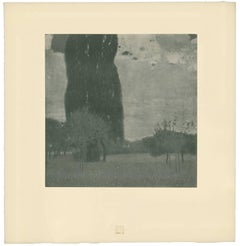Vienna Secession Prints and Multiples
to
2
65
112
2
2
Overall Width
to
Overall Height
to
21,006
18,672
10,652
6,326
5,173
2,703
1,554
1,447
1,366
886
869
442
344
199
46
28
19
15
11
26
155
76
27
29
23
98
83
136
73
59
59
53
30
25
24
13
12
12
12
11
11
9
8
7
7
5
5
141
47
5
3
2
15
180
1
Style: Vienna Secession
H.O. Miethke Das Werk folio "The Great Poplar I" collotype print
Located in Palm Beach, FL
DAS WERK GUSTAV KLIMTS, a portfolio of 50 prints, ten of which are multicolor collotypes on chine colle paper laid down on hand-made heavy cream wove paper with deckled edges; under ...
Category
Early 1900s Vienna Secession Prints and Multiples
Materials
Paper
Vienna Secession prints and multiples for sale on 1stDibs.
Find a wide variety of authentic Vienna Secession prints and multiples available for sale on 1stDibs. Works in this style were very popular during the 21st Century and Contemporary, but contemporary artists have continued to produce works inspired by this movement. If you’re looking to add prints and multiples created in this style to introduce contrast in an otherwise neutral space in your home, the works available on 1stDibs include elements of orange and other colors. Many Pop art paintings were created by popular artists on 1stDibs, including Gustav Klimt & K.K. Hof-und Staatsdruckerei, (after) Gustav Klimt, (after) Egon Schiele, and Gustav Klimt. Frequently made by artists working with Paper, and Lithograph and other materials, all of these pieces for sale are unique and have attracted attention over the years. Not every interior allows for large Vienna Secession prints and multiples, so small editions measuring 3 inches across are also available. Prices for prints and multiples made by famous or emerging artists can differ depending on medium, time period and other attributes. On 1stDibs, the price for these items starts at $250 and tops out at $125,000, while the average work sells for $3,500.
Recently Viewed
View AllMore Ways To Browse
Andy Warhol Coke
Andy Warhol Fish
Andy Warhol Flowers Poster
Andy Warhol Movie Poster
Architecture Prints Georgian
Bearbrick Pink
Dali Milky Way
Frank Romero On Sale
Gilles Aillaud
Gregory Colbert
Gretchen Dow Simpson
Gwenda Morgan
Jean Cocteau 1957
Jim Webb
Kaws Set 2 Clean Slate
Ken Rush
Lebanon Poster
Lebanon Vintage Poster
